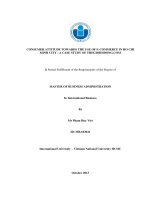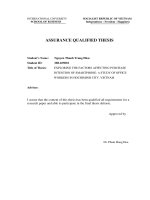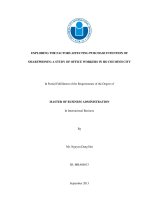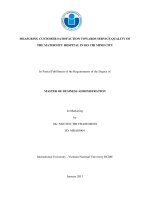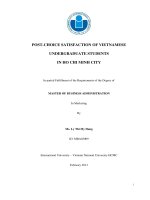Privatization a solution to the development of the private sector in Ho Chi Minh city
Bạn đang xem bản rút gọn của tài liệu. Xem và tải ngay bản đầy đủ của tài liệu tại đây (13.78 MB, 6 trang )
Public investment & restructuring of Public sector
This research is to investigate impacts of privatization on the development of privatized state-owned enterprises (abbreviated as SOEs) as part of the private sector. Such
development is measured by the pre- and post-privatization business performance of 63
HCMC-based SOEs, half of which were privatized in 2004. Results pointed out a substantial rise in profit, sale revenue, workforce, laborer’s income, and performance of
surveyed enterprises. The difference-in-differences (DID) estimator is employed to compare SOEs and privatized ones in terms of their performance in the same period; and
findings illuminated that privatized SOEs perform more efficiently. Besides, regression
analyses also show that factors affecting the performance include company size, state
ownership, and type of business. The research also reaffirms that the governmental decision on privatization is rational, and simultaneously manifests the impact of ownership modes on the business performance. Eventually, the research results can be
consulted by business administrators and policy-makers.
Keywords: privatization, SOEs, business performance, private sector
1. Introduction
As of the vcP 6th congress in 1986, vietnam’s
government has expedited the reform and restructuring for the sake of soes with a view to promoting the leading role of soes in the national
economy. since then, the privatization of soes is
deemed as an important factor in the vietnamese
economy in its transition from a centrally-planned
to a market-oriented mechanism. the reduction in
the state ownership in soes is a strategic remedy, that is, it sheds light on extant weaknesses
and drawbacks of the subsidy-based mechanism,
facilitates the mobilization of capital from the private sector, encourages a proactive management
and dynamic for development, and improves the
business performance.
2
Economic Development Review - May 2011
since open-door policies came into being, vietnam’s economy has gained a lot of striking socioeconomic achievements which are internationally
acknowledged. All sectors grew healthily, especially the private one with the participation of privatized soes. Yet, the point is whether the
privatization or the overall growth of national
economy in the context of international integration accounts for the development of privatized
soes. to untie this knot, the research is to compare the business performance of soes and privatized soes, and then investigate the pre- and
post-privatization growth of privatized soes and
influential factors.
2. Literature review
* University of Economics - HCMC
Public investment & restructuring of Public sector
many scholars in the world have conducted researches on impacts of privatization on the business performance by comparing the pre- and
post-privatization performance and financial outcome of enterprises. comprehensively, almost researches have proven that the privatization
substantially improved the financial outcome and
business performance. for example, it is after privatization that income, sale revenue, labor productivity and investments reached a high; and the
financial leverage sharply reduced. Yet, impacts
of privatization on the rise in employments are
not clear-cut. Actually, boubakri and cosset (1998)
pointed out that a considerable number of jobs
were created after the privatization, while megginson et al. (1994), D’souza and megginson
(1999), and D’souza et al. (2001) found that only
minute changes in employments took place after
privatization. la Porta and lopez de silanes
(1999) and Harper (2002) recognized a substantial
fall in employments after privatization.
3. Hypotheses and research model
based on theories on privatization and previous relevant findings, the research is to test the
following hypotheses:
H1: the performance of privatized soes is
higher than that of soes in the same period.
H2: the post-privatization performance is
higher than the pre-privatization performance.
H3: the company size, the existence of state
representative in the director board, the ratio of
state-owned equity, and the industry have significant impacts on the business performance.
research variables comprise:
- the dependent variable is the business performance which is measured by return on asset
(roA), return on equity (roe), profit margin
(Pm), sale revenue (sr), workforce (Wf), and laborer’s average income (li).
- the controlled variables that influence the
performance of soes are set forth in table 1.
the linear regression model that reflects impacts of independent variables on dependent ones
will be described as follows:
Y = b0 + b1siZe+ b2 oWnersHiP + b3Director + b4inD + e
Where, Y will respectively represent the return
on asset (roA), the return on equity (roe), the
profit margin (Pm), the sale revenue (sr), the
workforce (Wf), and the laborer’s average income
(li).
Table 1: Definition of controlled variables
Variables
Signs
Descriptions
Company
size
SIZE
It is the logarithm of average
sale revenue.
Ratio of
state –
owned
equity
It represents the ratio of
OWNERstate-owned equity at the
SHIP
point of privatization.
Director
board
DIRECTOR
Industry
IND
It is a dummy variable and
equal to 1 if the director represents the state holdings,
and zero otherwise.
It is a dummy variable and
equal to 1 in case of
trading/service companies,
and zero otherwise
4. Research methodology
- DiD technique was firstly employed for policy
researches by Ashenfelter and card in 1985 and
has been well-known since then. the basic premise of DiD is to examine a certain feature/criterion
of two group of samples at two different periods of
time. that is, a group is exposed to changes induced by a particular treatment/event in the second period but not the first one; and another group
will not in both periods. this is the first difference
between two groups. the second difference will be
worked out when conducting this treatment/event.
then, these two differences will be taken into account. to be more specific, in this research, the
two samples include soes and privatized soes in
Hcmc which will be examined at two different
point of time (i.e. before and after privatization).
the treatment/event here will be superseded with
privatization.
- the Wilcoxon paired signed-rank test is employed once an observed variable is influenced and
changed by exogenous factors. Accordingly, the
variable is divided into two samples, viz. before
being influenced and after being influenced. this
is a non-parametric test, and thus samples need
not abide by the normal distribution. Yet there is
a significant assumption that only one factor affects the sample at a certain point of time. in case
the turbulence takes place, this test will be re-
Economic Development Review - May 2011
3
Public investment & restructuring of Public sector
jected. this test is utilized to define whether or
not there is a difference in the pre- and post-privatization performance of soes (i.e. Hypothesis
2). to remove effects of inflation when carrying
out the test, the inflation rate is subtracted from
values of relevant variables (profit, sale revenue,
and laborer’s income). variables expressed in percentages do not need such subtraction. the
Wilcoxon paired signed-rank test is conducted as
per following steps:
step 1: setting the null hypothesis (H0): the
median of two samples is equivalent.
H0: medianafter influenced = medianbefore influenced
Ha: medianafter influenced > medianbefore influenced
step 2: the significant level is set at 5% (a =
0,05).
step 3: setting criteria to nullify H0: p-value ≤
0,05.
step 4: calculation of p-value.in case of oneside test: p-value = Asymp. sig. (2-tailed) / 2
in case of two-side test: p-value = Asymp. sig.
(2-tailed)
step 5: comparing the p-value with the set criterion in step 3
step 6: conclusion
With p-value ≤ 0,05, H0 is nullified; or in other
words, the median of two samples are not equivalent.
Another non-parametric test is the mannWhitney test which is employed to compare two
data groups of independent samples. it can be utilized in lieu of the t-test when normal assumptions
or the homogeneity of variances are unattainable.
like other non-parametric tests, mann-Whitney
test uses ranks of samples so as to run statistical
calculations. this test is employed to define
whether or not there is a difference in the preand post-privatization performance of soes; and
thereby draw conclusions that the high performance of privatized soes is not due to the overall
developmental trend of the market. the mannWhitney test is conducted as follows:
step 1: setting the null hypothesis (H0): the
median of two samples is equivalent.
H0: medianprivatized soes = mediansoes
Ha: medianprivatized soes > mediansoes
step 2: the significant level is set at 5% (a =
0.05)
4
Economic Development Review - May 2011
step 3: setting criteria to nullify H0: p-value ≤
0.05
step 4: calculation of p-value
in case of one-side test: p-value = Asymp. sig.
(2-tailed) / 2
in case of two-side test: p-value = Asymp. sig.
(2-tailed)
step 5: comparing the p-value with the set criterion in step 3
step 6: conclusion
With p-value ≤ 0.05, H0 is nullified; or in other
words, the median of two samples are not equivalent.
5. Data collation
numerical data are collated from financial
statements submitted to the Hcmc tax bureau in
the period 2001-2007 when there was not impact
of the global financial crisis on the business performance. the sample size is 63 Hcmc-based
soes and 31 of which were privatized in 2004.
6. Research results
the research results are set forth in tables 2,
3 and 4 below.
Table 3: Wilcoxon paired signed-rank test for indicators of business performance
Indicator
ROApost-privatization –
ROApre-privatization
ROEpost-privatization –
ROEpre-privatization
PMpost-privatization –
PMpre-privatization
SRpost-privatization –
SRpre-privatization
WFpost-privatization –
WFpre-privatization
LIpost-privatization –
LIpre-privatization
Sign
of values
Mean
ranks
N
-
3
6.67
+
28
17.00
Equal
-
0
8
12.00
+
23
17.39
Equal
-
0
5
11.60
+
26
16.85
Equal
+
Equal
+
Equal
-
0
30
0
28
0
3
+
28
16.14
Equal
-
0
12
13.62
+
19
17.50
Equal
-
0
7
13.71
+
24
16.67
Equal
+
0
14
13.21
Equal
0
16.10
17.29
14.67
Public investment & restructuring of Public sector
Table 2: Descriptive stat for indicators of business performance
Indicator
Before privatization
Unit
Median
After privatization
Standard
deviation
Standard
deviation
Median
Asymp. Sig.
(2-tailed)
ROA
%
4.94
5.09
20.14
36.29
0.000
ROE
%
27.80
62.04
33.01
28.06
0.003
PM
%
5.97
5.86
12.94
13.37
0.000
SR
Million VND
269,394
439,966
445,062
925,055
0.000
WF
LI
Person
136
121
155
158
0.098
Million VND
2.64
1.13
2.98
1.18
0.000
in sum, in order to answer to the Hypothesis
2, the Wilcoxon paired signed-rank test was run
and produced a statistically significant p-value.
therefore, it is possible to conclude that the privatization has profound impacts on the business
performance. the results also point out the difference in the pre- and post-privatization performance of soes.
in order to test the hypothesis 1, the mannWhiteny test is employed with a view to evaluating whether the difference in the performance of
soes and privatized ones is statistically significant or not. However, to quantify the difference,
it is needed to re-run the Wilcoxon paired signedrank test for the pre- and post-privatization performance of soes. the value when the two
differences are subtracted from each other represents the difference generated by the privatization
process.
Due to the fact that surveyed enterprises are
all based in Hcmc and operate in the same period
of time, factors of time and macroeconomic administration affecting the performance of two groups
of enterprises have been left out. the results are
set forth in table 4 and 5.
Table 5: Mann-Whitney test for the differences in
rank of SOEs and privatized ones
Indi- Types of encators
terprises
ROA
Asymp.
Sig.
(2-tailed)
ROE
PM
SR
WF
LI
0,00
0,00
0,06
0,91
0,00
0,00
Mean
ranks
Total mean
ranks
SOEs 192
163.96
31,481
Privatized
186
SOEs
215.86
40,150
SOEs 192
154.49
29,663
Privatized
186
SOEs
225.63
41,968
SOEs 192
179.07
34,381
Privatized
186
SOEs
200.27
37,250
SOEs 192
188.91
36,271
Privatized
186
SOEs
190.11
35,360
SOEs 192
214.81
41,244
Privatized
186
SOEs
163.37
30,387
SOEs 192
162.33
31,167.5
Privatized
186
SOEs
217.55
40,463.5
Total 378
ROE
Total 378
PM
Total 378
SR
Table 4: Differences in the performance of SOEs
and privatized ones
ROA
N
Total 378
WF
Total 378
LI
Total 378
Economic Development Review - May 2011
5
Public investment & restructuring of Public sector
Table 6: Summation of differences in the pre- and post-privatization performance
Privatized SOEs
SOEs
Before
privatization
After
privatization
Differences
Before
privatization
After
privatization
Differences
ROA
4.95
20.14
15.19
6.52
7.29
0.77
ROE
27.80
33.01
5.21
9.23
12.29
3.06
PM
5.97
12.94
6.97
6.30
8.51
2.21
SR
269,394
445,062
175,667
325,118
285,850
-39,268
WF
135.7
154.6
18.9
220.8
226.3
5.5
LI
2.6
2.98
0.38
1.97
2.42
0.45
by means of the above-mentioned results, it is
possible to conclude that:
firstly, the performance of privatized soes is
higher than that of soes. based on the difference,
the privatization process, if macroeconomic factors
are excluded, has generated a rise of 14.43% for
roA, 2.16% for roe, and 4.76% for the profit
margin.
secondly, for privatized soes, the sale revenue
also increases but does not carry any statistical
significance; the workforce increases 13.41 persons and has a statistical significance; and the laborer’s income falls by vnD0.07 million as
compared to that of soes.
Table 7: P-values and sign of beta coefficients in regression equations
Observed ROA
variables
ROE
PM
SR
WF
LI
0.06
0.8
0.54
0.01
0.44
0.45
-
-
-
+
-
-
OWNERSHIP
0.14
0.18
0.49
0.70
0.68
0.13
-
-
-
+
-
+
DIRECTOR
0.97
0.28
0.96
0.64
0.95
0.34
+
+
+
+
-
-
0.54
0.45
0.31
0.19
0.69
0.01
-
+
+
-
-
+
SIZE
IND
the effect of company size on roA and the sale
revenue is statistically significant at 1% and 5%
respectively. the influence of oWnersHiP on
roA is statistically significant with the negative
coefficient; or in other words, the larger the state
6
Economic Development Review - May 2011
ownership, the smaller the roA. in addition, the
variable Director does not have any statistically significant relationship with the business
performance; that is, the effect of the state representative in privatized soes is quite humble. finally, the variable iDn has impacts on the
laborer’s income. those who work for trading and
service companies will be paid higher than those
in other industries.
7. Conclusion and implications
this study has proven impacts of privatization
on the performance of soes in vietnam. it is apparent that the profit, sale revenue, and laborer’s
income are substantially improved after privatization. these findings have consolidated empirical
results which surmise that an enterprise will perform more efficiently after privatization. for the
case of vietnam soes, although state representatives and in-company staff still hold the majority
of stocks and shares after privatization, their business performance has been dramatically improved. Whilst, some other research has shown
that the substantial improvement in the business
performance is mostly related to the majority
holding of out-companies shareholders (see earle
& estrin, 1996).
the research advocates the findings by megginson et al. (1994), boubakri & cosset (1998),
and D’souza & megginson (1999), which point out
that there is a rise, although quite humble and not
statistically significant, in employments in privatized soes. such the findings stand in the total
Public investment & restructuring of Public sector
contrast to those by boycko et al. (1996) which
suppose that the positive impact of privatization
on the business performance primarily derives
from the efficient and rational employment and
the avoidance of redundancy. the rise in employment in vietnam’s privatized soes may be due to
the expansion of business scope which is reflected
on the increase in sale revenue and the substantial rise in laborer’s income. thus, it is possible to
affirm that the privatization has dramatically improved the performance of soes, which dates back
to the positive impacts of private ownership in
soes.
deduced, or the government had better not invest
in small and medium-sized enterprises or those
not belonging to key industries. furthermore, in
order to promote the sustainable economic growth
on the basis of improvements in business performance, the government and competent authorities
should expedite the privatization process which
has become sluggish thus farn
besides, the regression results figure out a negative impact of the company size on roA; and
thus support the hypothesis, that is, small-size
soes will be more flexible in post-privatization
restructuring with a view to generating more return on assets. Yet, the company size has a positive effect on the sale revenue of vietnam’s
privatized soes and it is the most important factor affecting the performance of privatized soes.
lastly, the larger the state holdings, the smaller
the roA.
2. Cheelo, Caesar & T. Munalula (2005), The Impact
eventually, the privatization of soes is an inevitable process and cannot be detached from the
development of the private sector in vietnam
economy. this process has substantially improved
the performance of privatized soes. Yet, it is suggested that the state holdings should be gradually
References
1. Boubakri, Narjess and Jean-Claude Cosset (1998),
“The Financial and Operating Performance of Newly Privatized Firms: Evidence from Developing Countries”,
Journal of Finance, Vol.53.
of Privatization on Firm Performance in Zambia, University
of Zambia Department of Economics.
3. Hakro, Ahmed Nawaz & M. Akram (2009), “PrePost Performance Assessment of Privatization Process
in Pakistan”, International Review of Business Research
Papers.
4. Micco, Alejandro, U. Panizza & M. Yanez (2004),
Bank Ownership and Performance, Inter-American Development Bank.
5. Ramasamy, Bala, D. Ong & M. C. H. Yeung (2005),
“Firm Size, Ownership and Performance in the Malaysian
Palm Oil Industry”, Journal of Accounting and Finance,
Asian Academy of Management.
Economic Development Review - May 2011
7





